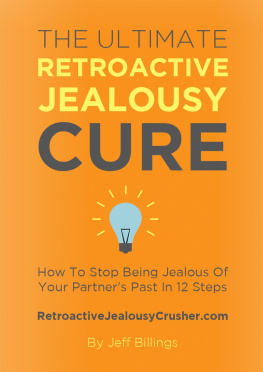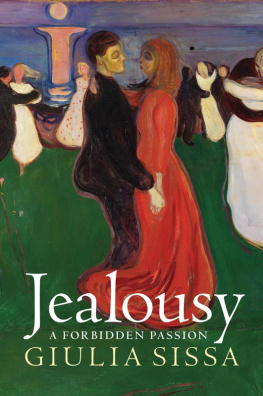Romantic
Jealousy
Causes, Symptoms, Cures
Ayala Malach Pines




Romantic
Jealousy
Other Books by Ayala Malach Pines
Couple Burnout: Causes and Cures
(Routle(Ige)
Career Burnout: Causes and Cures
Experiencing Social Psychology: Readings and Projects
(with Christina Maslach)
The Juggler. A Working Woman: Problems and Solutions
(available in Hebrew)
Psychology of Gender
(available in Hebrew)
How We Fall in Love
(forthcoming from Routledge)
For Israel
Contents
ix
xiii
Preface
In the summer of 1978, 1 flew back to San Francisco from Toronto, where I had attended a convention of the American Psychological Association. On the plane I sat next to Elliot Aronson, one of the leading social psychologists in the country and a dear friend whom I admire greatly. We were chatting about various things when he said, "What do you know about jealousy?"
"Jealousy?" I responded, surprised. Ile explained, "I was asked to write an article called 'What We Don't Know About Jealousy' for a new behavioral science magazine. The problem is that I don't know much about jealousy-hence the title. But I thought if you were interested in the subject, we could pool our ignorance and have some fun writing the article together." While I definitely had my own personal experience with jealousy, I had never given much thought to it as a subject for study. I knew as much about it as Elliot did, but the offer was such a great compliment that I said yes right away.
The next clay, in Berkeley, I went to the university library and did a computer search to find out what had been written about jealousy. There was quite a lot. I buried myself in literature on romantic jealousy written by novelists, poets, philosophers, anthropologists, sociologists, psychiatrists, and psychologists. While the volumes written were enormous, many questions were left unanswered. This was the subject of the article Elliot and I wrote.
Although the magazine folded before the article could be published, I became "hooked" on jealousy and, for the following twenty years, continued to study it. I've worked with jealous individuals and couples in my private practice both in California and Israel and have led jealousy workshops and collected questionnaires from close to a thousand people. I've worked in prison with male inmates serving time for "crimes of passion" and both inter viewed and collected questionnaires from female inmates. I've worked with couples in open relationships. I've studied two urban communes practicing open relationships: one in which members succeeded in overcoming their jealousy, the other in which jealousy was a major problem and eventually caused the break-up of the commune. I've also reviewed the extensive and steadily growing literature on jealousy. This book is based on these experiences, research, and clinical work.
The book describes five different approaches to jealousy. The psychodynamic approach, which is particularly interested in delusional jealousy, views it as the result of unresolved childhood traumas. The systems approach views jealousy as the result of the dynamics within a particular relationship. The cognitive-behavioral approach views it as a learned response that when inappropriate can be unlearned. The social-psychology approach views it as a result of cultural forces that determine when jealousy is experienced and how it is expressed. The evolutionary or sociobiological approach views jealousy as innate, the result of evolutionary processes that appear to be different for men and women (Pines, 1992a).
While these approaches are considered by many theoreticians to be contradictory, I use all five of them in any work. I believe anything that helps a person with a jealousy problem can and should be used. This book reflects that conviction.
What the Book Is About
This book is for anyone who seeks a better understanding of romantic jealousy. It was written with three kinds of readers in mind. The first is the clinician who works with people struggling with a jealousy problem. The second is the person who struggles with a jealousy problem or with a mate's jealousy. The third is the intellectually curious person who might have encountered jealousy, either within himself or herself or in another, and is interested in learning more about it. Each chapter should have something for all three types of readers.
A person suffering from a jealousy problem is most likely to benefit from answering The Romantic Jealousy Questionnaire (see Appendix B) both before and after reading the book. The questionnaire can also be used by researchers and by therapists working with people with a jealousy problem. It is best to use it both before and after therapy. The intellectually curious reader is invited to answer the questionnaire just for fun.
The first chapter serves as an introduction. It defines jealousy and explains the differences between jealousy and envy and between jealousy that is normal and abnormal, chronic and acute.
The second chapter addresses a series of questions (as presented in The Romantic Jealousy Questionnaire) that are aimed at helping readers explore their romantic jealousy and compare their responses to those given by over seven hundred people.
The third chapter explores the unconscious roots of jealousy from the perspective of the psychodynamic approach, which views jealousy as a problem in the mind of the jealous individual that is best treated by individual therapy. This chapter shows how childhood events help shape adult jealousy.
The fourth chapter presents the systems approach, which proposes that jealousy occurs within the dynamic of a particular relationship and can best be treated through couple therapy. The chapter shows how couples collude to keep a jealousy problem alive.
The fifth chapter presents the sociobiological approach, in which jealousy is seen as an innate response resulting from evolutionary forces that are different for men and women. The chapter suggests that jealousy may be a universal problem for couples.
The sixth chapter discusses jealousy in different cultures and presents the social-psychological approach. According to this approach, the culture determines when people feel jealous and how they express their jealousy. The social-psychological approach encourages people to make an attributional shift in their explanation for their jealousy from "I'm a jealous person" to "I get jealous in certain situations."
Chapters seven and eight examine the range of responses to romantic jealousy. One chapter discusses people who succeeded in overcoming their jealousy and have established long-term open relationships. The other chapter discusses people who were overcome by their jealousy and committed crimes of passion. Whereas chapter seven presents the views of people who believe that jealousy is learned and thus can also be unlearned, chapter eight presents the view that, under the all-powerful influence of the green-eyed monster, some people can become temporarily insane and commit the most "monstrous" and violent crimes. The chapter provides an opportunity to gain an appreciation for the explosive potential in jealousy and learn how to defuse it.


















